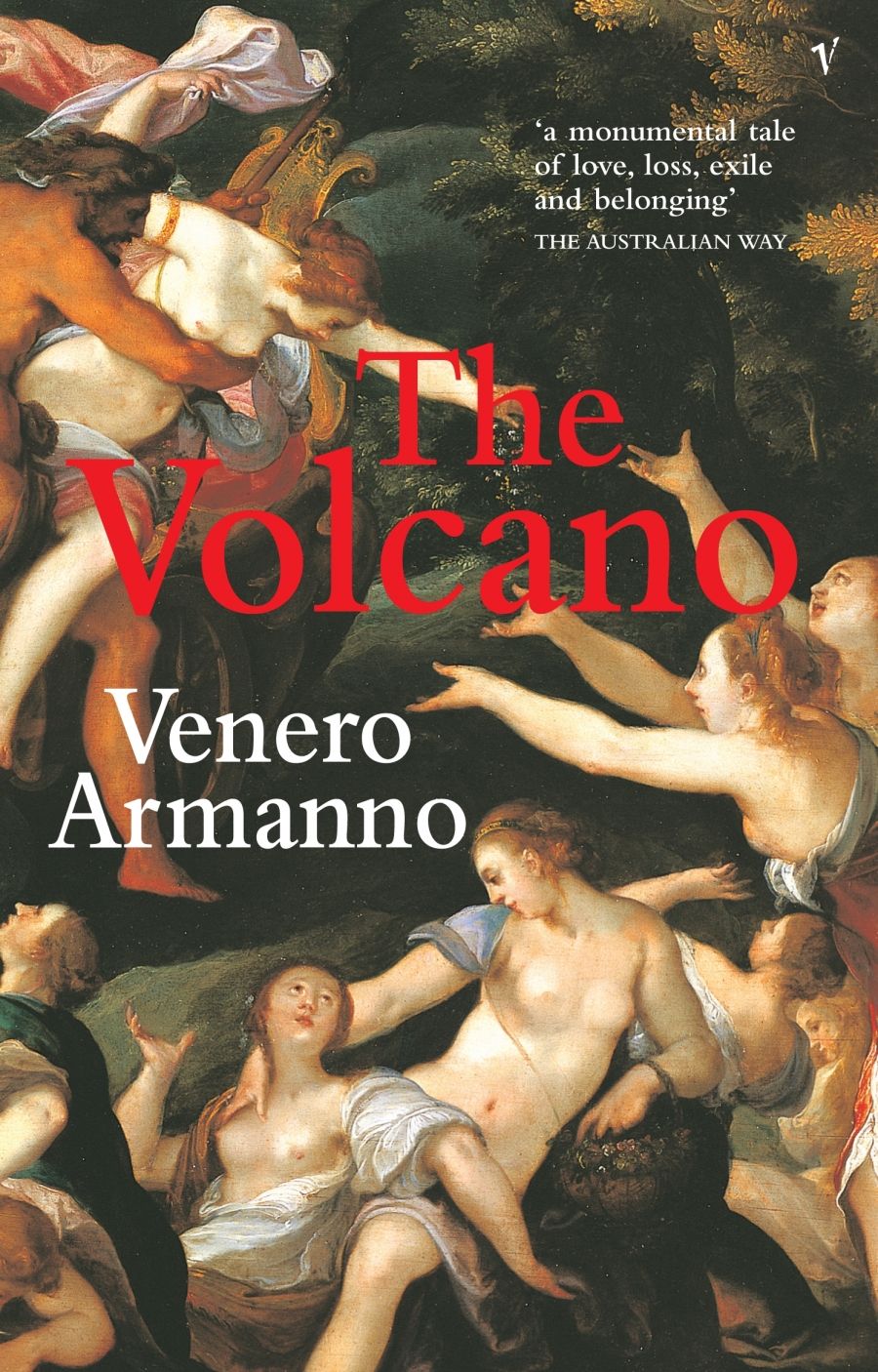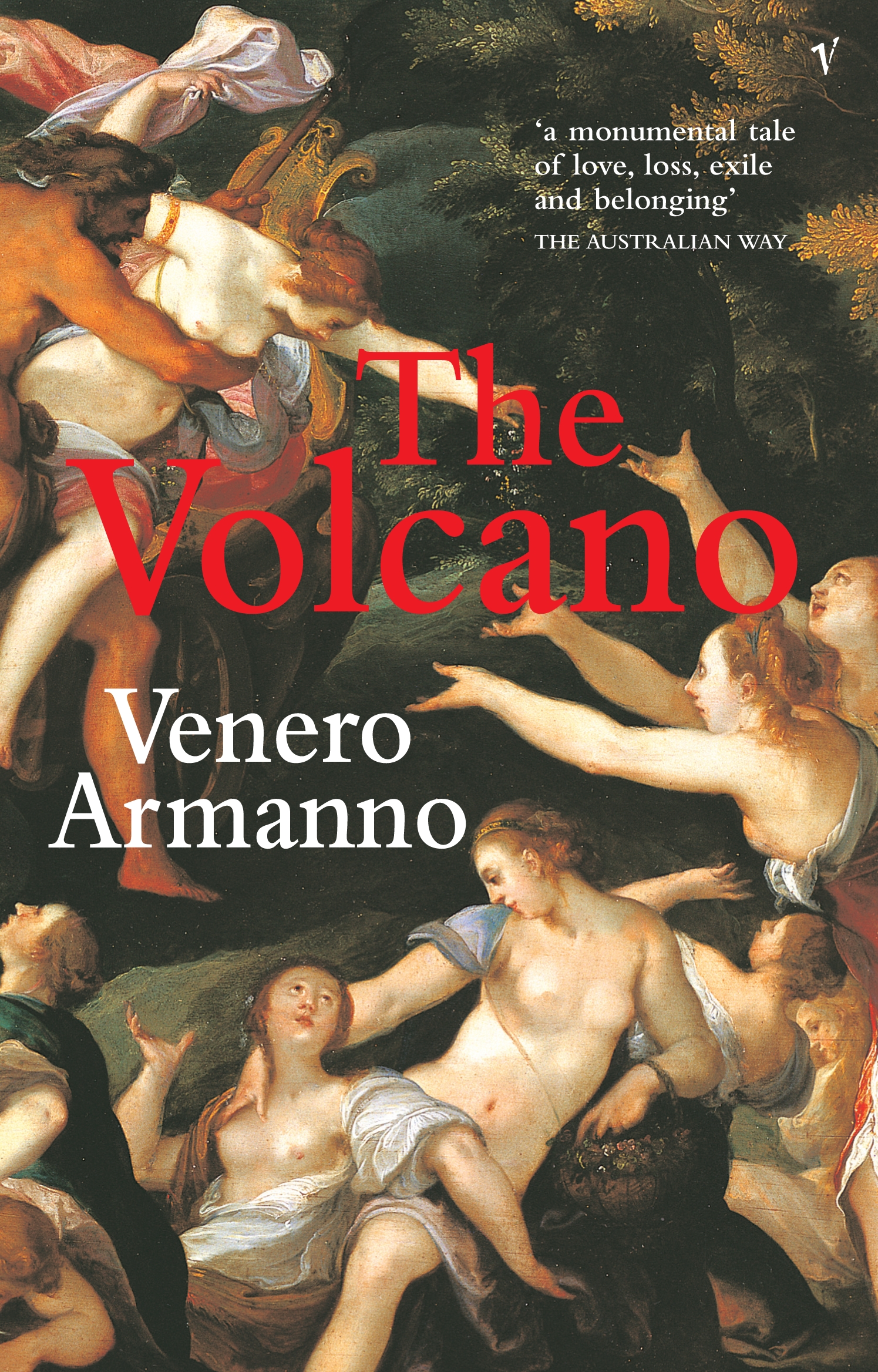
- Free Article: No
- Contents Category: Fiction
- Review Article: Yes
- Article Title: A Lush Novel
- Online Only: No
- Custom Highlight Text:
In 1969,’ says Venero Armanno in the letter to the reader that prefaces his new novel, ‘my parents took me to Sicily for the first time, and we lived for six months in the tiny village of their birth. What I remember most clearly … is the presence of the volcano, and just how absolutely it dominates life. It’s there smoking silently in the day, and at night … you can see the fiery glow in the mouth of cratere centrale – that fire which can never be put out.’
- Book 1 Title: The Volcano
- Book 1 Biblio: Random House, $45 hb, 683 pp
- Book 1 Cover Small (400 x 600):

At sunrise in the first sentence, an old man wakes up on a hot Brisbane morning surrounded by the ghosts of his eventful life. Emilio Aquila – hero, villain, and human volcano – thinks back to Sicily in 1943, where, at fifteen, he’s given a life-changing lesson about violence and cruelty, and that’s where it all starts. (If you want to know the rest of the plot, you’ll have to read the book.) This ‘novel of emotion, passion and fire’ is about crime, desire, food, love, migration, masculinity, mythology, the architectural and sociological history of Brisbane in the second half of the twentieth century, and the appalling effort it takes to try to be a good person over the course of a long life. And volcanoes. Mt Etna’s name comes from the Greek Aetna, ‘I burn’; it might be Emilio Aquila’s epitaph.
Sometime during the 1980s, a category emerged in Australian literary culture called ‘migrant writing’. Scholarly articles, university courses, anthologies and funding-body budget lines were devoted to it. Robert Dessaix wrote an influential essay about it in this very journal. It retroactively embraced the work of migrant writers of the 1950s and 1960s like Judah Waten and David Martin; it rather gingerly examined the odd phenomenon of They’re a Weird Mob; and it opened up opportunities for contemporary writers with non-Australian backgrounds – people like Rosa Cappiello and Ania Walwicz and Brian Castro – to say different things, and say them differently, from any of the ways that things in Australian literature had hitherto been allowed to be said, and to be filled, if that was how they felt, with frustration and rage.
But by the mid-1990s, younger European-Australian writers like Fotini Epanomitis and Christos Tsiolkas were no longer being identified so much with the ‘migrant’ category as with the genres in which they were working; ‘migrant writing’, having gone through the stage of separatism historically necessary for getting noticed and accepted, became simply one more part of the country’s increasingly heterogeneous literary output. And a book like The Volcano couldn’t have been written without that hinterland, the historical trajectory of the post-war migrant experience and its literature.
Like Epanomitis and Tsiolkas, Venero Armanno was born in Australia of immigrant parents; like theirs, his work shows the complexity, the exuberance and the linguistic confidence and playfulness of his origins. The Volcano is full of feeling and detail, whole-hearted and lush. Readers who embrace the minimalists’ sad little skim-milk slogan ‘less is more’ probably won’t like it much; if you’re out of sympathy with excess in any of its forms, and out of sympathy with hallucinations, dreams, visions and conversations with the absent and the dead, this is not the book for you. While its mode is still essentially realist, it’s as far from the dreaded ‘dun-coloured realism’ as even Patrick White could have wished; red and gold realism, perhaps, as when the fifteen-year-old Desideria tips a dish of ravioli in sauce all over her prospective husband, chucks her diamond engagement ring into the minestrone, and then sits down to a hearty lunch of veal shanks with garlicky potatoes and rosemary, or as when Emilio’s friend and erstwhile landlord, the sad and virtuous Dr Thach Yen-Khe, describes him thus: ‘over seventy years of age, one-eyed, hiding waterworks problems and very plainly seeing into the afterworld.’
I suppose all reviews have to have some sort of quibble. Mine, a very minor one, is to do with all this bountifulness: maybe there’s occasionally just a bit too much information, a bit too much verbal untidiness, a bit too much overt insistence on the volcano symbolism and on the book’s informing myth, the abduction and rape of Persephone by Hades. Occasionally, the reader might feel just a little bit hit over the head. But if, like me, you belong to the anti-minimalist school (slogans: ‘Less is less’ and ‘Better too much than not enough’), you won’t much care.
Given the current state of the world, the reader is more than usually grateful for this novel’s refusal of easy distinctions, polarisations, binary oppositions, and any other conceptual way of seeing the world in black and white. Sicily/Australia, reality/imagination, hero/villain, death/life, love/hate and good/evil are all oppositions that the story systematically undermines. Obviously already very sick, and then savagely beaten up after out of a place he calls Halfway – ‘from here an individual can see perfectly in all directions’ – and we are left in no doubt about the desirability of being there.
There’s a vast cast of characters and even the most minor are brilliantly drawn, from the gentle, lonely Thach Yen-Khe, the terrifying Oscar Sosa and the even more terrifying Desideria, to the dreadful Associate Professor Arnold Yell and the gorgeous Faith Muirhead. Even the most minor characters, like young Darryl, the walk-on burglar, are sketched in three pencil strokes with absolute confidence. And then, of course, there’s Emilio himself, a sort of 1990s Sicilian Zorba and all-round force of nature.
The Volcano was first written as a six-hour, feature-film screenplay. To the novel’s great benefit, these origins are still clearly in evidence. Writing for the screen is about pictures, not words: teachers of screenwriting will tell you that the basic structural unit of a screenplay is not the word or the sentence, but the image, and that the narrative should unfold shot by shot and scene by scene. Here the result is a book that should be set as required reading for Creative Writing classes as an example of the basic rule that goes: ‘Show, don’t tell.’
And, at a whopping 683 pages, this novel still manages to have no slow patches. There’s scene after scene that would be a gift to any director and to any actor: scary fights, elaborate meals, glittering parties and heartbreaking confrontations, all in the brightly coloured and oddly disquieting settings of Brisbane and Sicily. It is, as Armanno realised himself, too long a story for a movie, and there are other ways in which the novel form gives this material more room to move. But if he ever felt like turning it back into a screenplay, say a six-part television series, he could probably save the ABC single-handed.


Comments powered by CComment